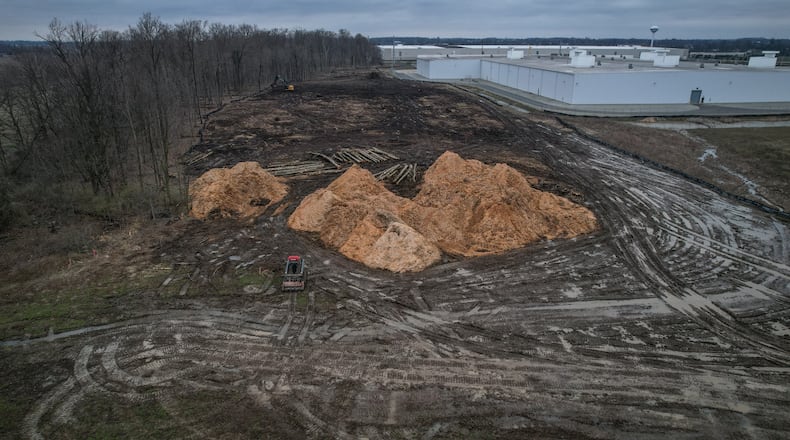Since then, it has swiftly dwindled. According to the U.S. Fish and Wildlife Service, the population has declined by half since the species was listed as endangered.
A 2019 winter census estimated a population of 537,297 bats in 16 states.
Bats serve an important role in the ecosystem, providing significant positive impacts on the environment as insectivores and pollinators, biologists say.
“They’re tremendously important, and as an endangered species, we have an obligation to conserve them,” Parham said.
According to the U.S. Department of the Interior, bats can eat their body weight in insects each night, and some studies have estimated bats save U.S. agriculture up to $53 billion annually in pest control.
“They’re also just really cool,” said Eileen Wyza, biologist for the Department of Natural Resources’ Ohio Division of Wildlife, adding that bats are even more closely related to humans than birds.
“They’re the only relative of humans that can fly,” she said. “They’re a really cool, unique group of species, so having and keeping them around to appreciate is a big thing.”
Population reductions can be attributed to disease, human disturbance of hibernating bats and the commercialization of caves where the bats hibernate.
But they also face a loss of summer habitat. That’s where Ohio enters the story.
The habitat loss became a growing topic of concern for some area environmentalists as commercialization and the development of formerly untouched land sees the removal of some potential bat habitat.
A proposed industrial project in Brookville, spearheaded by General Motors, has included the preliminary removal of some forested area, leaving some nearby residents anxious about the potential environmental impacts, including to local bat populations.
“They require a heterogeneous habitat, not just solid forest, wall to wall,” Wyza said. “They like to be near bodies of water and in areas that have some edge or some openings because that’s where it’s easiest to forage for insects, but they do need that forest;. That is where they’re physically roosting and raising their babies during the summer months.”
The proposal involves the expansion of GM’s current DMAX facility, located at 101 W. Campus Blvd., off of Collective Way.
Project plans include the addition of 1.3 million square feet of manufacturing and administration space, according to permit applications submitted to the Ohio Environmental Protection Agency, along with 0.7 million square feet of parking, truck lane and docking. The project will also reconstruct or reroute 2,550 linear feet of Campus Boulevard.
According to EPA spokesperson Dina Pierce, GM’s application includes plans to fill three “small, isolated wetlands” on the site, including two Category 2 wetlands of 0.12 and 2.11 acres, and one Category 1 wetland of 0.32 acres.
Ohio categorizes wetlands in three categories that identify whether threatened or endangered species live there, starting with Category 1 (none) to Category 3 (high).
Pierce noted Ohio rules require projects like the GM proposal to mitigate any wetlands impacts by preserving or restoring wetlands elsewhere in Ohio.
“GM is proposing to buy mitigation credits with The Nature Conservancy to protect or restore wetland acreage in either the Lower Great Miami River or Whitewater River watersheds,” Pierce said.
The nearly 10-acre forested land and wetlands in question are situated between the current DMAX facility and Brubaker Grain & Chemical. Further west is Foxhole Farm, a locally owned farm and shop selling produce, plants and other goods.
Foxhole Farm owners Sam and Rich Wickham have been vocal about their opposition to the expansion project. They say the multi-billion dollar company should instead expand east, where there is less densely-forested area, to avoid impacts to existing flora and fauna — including the endangered and protected Indiana bat — and the Wolf Creek Waterway.
“We understood this to be protected wetlands and endangered Indiana bat habitat as well as a buffer between our community and the watershed here, the Wolf Creek Waterway, which leads to the Great Miami River,“ Sam Wickham said in March. “Industry and the waterway do not need to mingle.”
During a Brookville council meeting the following month, Rich Wickham addressed city leaders to express his concern with the project, and how information about the plans has been disseminated to residents.
“I’m upset with how GM and the EPA have handled this, as they’ve not really communicated with anybody, and maybe they don’t have to ... but a little bit of communication would go a long way with these bigger projects,” he said.
Anna Kamnyev, environmental manager for the Ohio EPA’s Division of Surface Water, said this week the EPA is conducting a technical review of the project with action expected by June 18. A permit could then be issued, possibly after public notice and comment, depending on the permit type.
In late March, GM confirmed the company began site-clearing work. This was tentatively approved by the Ohio EPA while the agency processes the full permit application.
“Ohio EPA gave GM approval to hand clear the trees in the wetlands so they could meet the requirement to do the work before the Indiana bat roosting season,” Pierce said. “Approval to hand clear means they cannot use heavy machinery, such as a bulldozer.”
U.S. Fish and Wildlife Service spokeswoman Georgia Parham said Indiana bats — identifiable by their relatively small, mouse-like ears and particularly social nature — can live anywhere in Ohio, and forested habitat is critical to the species’ survival during summer months.
While a female Indiana bat may travel hundreds of miles once she emerges from hibernation in search of summer habitat, that varies widely based on a number of factors, including what habitat is available.
“It may be as few as 20 miles or up to several hundred,” Parham said. “The average distance is about 100 miles, (and) they tend to return to the same maternity habitat each summer and the same hibernaculum in the winter.”
Parham said representatives of GM approached the agency last year to ask about recommended procedures to limit the effects on the local ecosystem.
According to a letter dated Sept. 28, 2022, from the fish and wildlife service to GM representatives, the proposed project location is within the vicinity of one or more confirmed Indiana bat records, but that record is around 2.5 miles from the project.
The letter also recommends GM complete a summer survey of the location to determine if the specific land in question is a summer habitat location for Indiana bats.
“If a summer survey documents probable absence of Indiana bats at the project location, tree clearing on the project site at any time of the year is unlikely to result in adverse results to Indiana bats,” the letter reads.
If a summer survey is not completed, Parham said the fish and wildlife service advises project developers conduct any tree-clearing only during the bats’ typical hibernation period, from Oct. 1 through March 31, which GM did abide by.
Threats to Indiana bats include wind turbine farms, which can injure or kill traveling bats, along with a relatively new fungal disease known as white-nose syndrome.
“We’ve seen up to 99% population decline in our cave-hibernating bats, so it became very serious very quickly,” Wyza said. “It’s something that’s extremely difficult to treat and there is no cure.
The fungus thrives in cool, moist environments and spreads easily among bats hibernating in clusters along cave walls, Wyza said.
“The fungus is an irritant, so it can wake the bats up because it’s on their face or their wings, and if they’re waking up out of hibernation in the winter, there’s nothing for them to eat, so a lot of these bats are dying from starvation,” she said.
Wyza said it’s not yet known how or why the remaining bat population has been able to survive overwhelming threat of white-nose syndrome.
“We’re seen over 95% decline in populations for hibernating bats but the remaining 1% to 4% is still hanging on,” she said. “As to why that’s happening, we’re still looking into it.”
There’s a chance that some bats may be afflicted with white-nose syndrome during hibernation but remain in a hibernating state. Once temperatures rise, the fungus can no longer survive.
“If they make it through the winter, and to a time when there’s food, then they’ll probably survive,” Wyza said, speculating that there is a potential for bats to change their behavior to avoid susceptibility to the fungus but more research will need to be done on this subject.
“(Perhaps) it’s a genetic component that’s helping some bats survive, or a behavioral change, like choosing different caves that are slightly warmer or slightly colder, or even being less social and not clumping together,” Wyza said. “It’s uncertain whether bats themselves are changing their behavior or if it’s just those that are already acting a little differently that are surviving.”
About the Author




